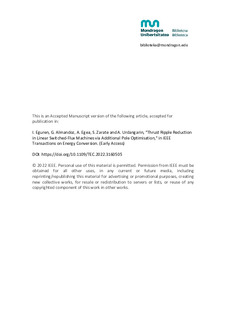Izenburua
Thrust Ripple Reduction in Linear Switched-Flux Machines via Additional Pole OptimisationEgilea (beste erakunde batekoa)
Beste instituzio
Orona EICBertsioa
Postprinta
Eskubideak
© 2022 IEEE. Personal use of this material is permitted. Permission from IEEE must be obtained for all other uses, in any current or future media, including reprinting/republishing this material for advertising or promotional purposes, creating new collective works, for resale or redistribution to servers or lists, or reuse of any copyrighted component of this work in other works.Sarbidea
Sarbide irekiaArgitaratzailearen bertsioa
https://doi.org/10.1109/TEC.2022.3160505Non argitaratua
IEEE Transactions on Energy Conversion Argitaratzailea
IEEEGako-hitzak
End effect
Linear machines
Optimisation
Ripple ... [+]
Linear machines
Optimisation
Ripple ... [+]
End effect
Linear machines
Optimisation
Ripple
Switched-Flux
magnet [-]
Linear machines
Optimisation
Ripple
Switched-Flux
magnet [-]
Laburpena
Linear switched-flux machines are a kind of permanent magnet machine with a passive ferromagnetic secondary. Therefore, they can achieve both a good performance and a low cost in long stroke applicati ... [+]
Linear switched-flux machines are a kind of permanent magnet machine with a passive ferromagnetic secondary. Therefore, they can achieve both a good performance and a low cost in long stroke applications. However, due to the end effect, these machines generate high detent force and on load thrust force ripples. There are several solutions in the literature that aim to minimise the thrust ripple. One of those solutions is the placement of additional poles in the ends of the machine. These can be passive, i. e. simple ferromagnetic teeth, or active, with additional magnets. The former is the most common solution in the literature. In this article, the optimal configuration of the additional poles is discussed via 4 additional pole sizing strategies, and the influence of the design variables and optimisation objectives is analysed. Then, a generic additional pole configuration is proposed, which combines a high effectiveness and a simple design. Finally, an experimental validation is carried out, and the measurements confirm the results from the optimisation. [-]






















